Tea Production in China
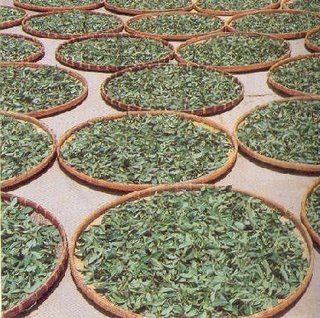 A new tea plant Production in China must grow for five years before its leaves can be picked and, at 30 years of age, it will be too old to be productive. The trunk of the old plant must then be cut off to force new stems to grow out of the roots in the coming year. By repeated rehabilitation in this way, a plant may serve for about l00 years.
A new tea plant Production in China must grow for five years before its leaves can be picked and, at 30 years of age, it will be too old to be productive. The trunk of the old plant must then be cut off to force new stems to grow out of the roots in the coming year. By repeated rehabilitation in this way, a plant may serve for about l00 years.For the fertilization of tea gardens, soya-bean cakes or other varieties of organic manure are generally used, and seldom chemical fertilizers. When pests are discovered, the affected plants will be removed to prevent their spread, and also to avoid the use of pesticides.
The season of tea picking depends on local climate and varies from area to area. On the shores of the West Lake in Hangzhou, where the famous green tea Longjing (Dragon Well) comes from, picking starts from the end of March and lasts through October, altogether 20-30 times from the same plants at intervals of seven to ten days. With a longer interval, the quality of the tea will deteriorate.
The new leaves must be parched in tea cauldrons. This work, which used to be done manually, has been largely mechanized. Top-grade Dragon Well tea, however, still has to be stir-parched by hand, doing only 250 grams every half hour. The tea-cauldrons are heated electrically to a temperature of about 25 C or 74 F. It takes four pounds of fresh leaves to produce one pound of parched tea.
The best Dragon Well tea is gathered several days before Qingming (Pure Brightness, 5th solar term) when new twigs have just begun to grow and carry "one leaf and a bud." To make one kilogram (2.2 lbs) of finished tea, 60,000 tender leaves have to be plucked. In the old days Dragon Well tea of Chinese tea this grade was meant solely for the imperial household; it was, therefore, known as "tribute tea".
For the processes of grinding, parching, rolling, shaping and drying other grades of tea various machines have been developed and built, turning out about 100 kilograms of finished tea an hour and relieving the workers from much of their drudgery.
[ Source : from chinaculture.org ]











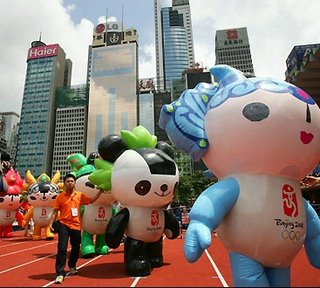 The name Friendlies has been abandoned as the organization committee for the 2008 Beijing Olympics silently changed the English name of the Games' five mascot dolls last week.fuwa, beijing olympics, 2008 beijing The organization committee decided to adopt the name "Fuwa",which is a literal, pinyin translation of its Chinese name and is more frequently used in China.
The name Friendlies has been abandoned as the organization committee for the 2008 Beijing Olympics silently changed the English name of the Games' five mascot dolls last week.fuwa, beijing olympics, 2008 beijing The organization committee decided to adopt the name "Fuwa",which is a literal, pinyin translation of its Chinese name and is more frequently used in China.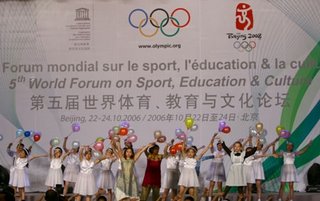 Hosting the 2008 Olympic Games not only can help spread the Olympic Spirit, but also can be helpful to upgrade the status of the hosting country, improve the population quality and develop the economy. This is why so many countries bid for the Games every time.China has a population accounting for one fifth of the world's total population. Therefore, it is a matter of course for China to bid for the Olympic Games.In early 1945, when China had just won the Anti-Japanese War, the first Chinese Olympic commissioner Wang Zhengyan, Chinese gymnasts Yuan Dunli and Dong Shouyi lodged a request to hold the 15th Olympic Games in 1952. The action created a big stir in China.
Hosting the 2008 Olympic Games not only can help spread the Olympic Spirit, but also can be helpful to upgrade the status of the hosting country, improve the population quality and develop the economy. This is why so many countries bid for the Games every time.China has a population accounting for one fifth of the world's total population. Therefore, it is a matter of course for China to bid for the Olympic Games.In early 1945, when China had just won the Anti-Japanese War, the first Chinese Olympic commissioner Wang Zhengyan, Chinese gymnasts Yuan Dunli and Dong Shouyi lodged a request to hold the 15th Olympic Games in 1952. The action created a big stir in China.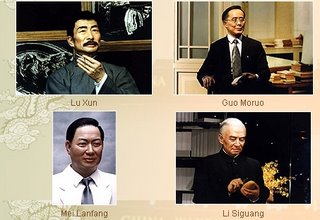
 The inhabitants of Beijing and the tourists will be able to see during "the week out of gold" of the national Festival the Palate of Potala the railway line Qinghai-Tibet and the Stopping of the three throats. All that, without having to leave the Place Tian' anmen. To achieve this exploit, there did not need to have recourse to a miracle of technology. they are only counterparts of these three sites. Among colourful attractions, one will be able to also see a floor set of themes made up of hundreds of thousands of flowers out of pot and giant statues with the effigy of the 5 mascots of the OJ of 2008.
The inhabitants of Beijing and the tourists will be able to see during "the week out of gold" of the national Festival the Palate of Potala the railway line Qinghai-Tibet and the Stopping of the three throats. All that, without having to leave the Place Tian' anmen. To achieve this exploit, there did not need to have recourse to a miracle of technology. they are only counterparts of these three sites. Among colourful attractions, one will be able to also see a floor set of themes made up of hundreds of thousands of flowers out of pot and giant statues with the effigy of the 5 mascots of the OJ of 2008.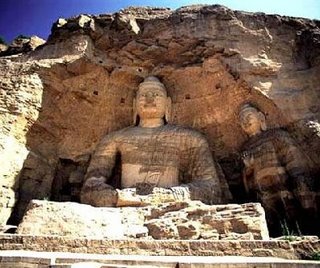 Datong, situated in the far north of Shanxi Province, covers a total area of 14,112.56 square kilometers, and averages at 700 to 1,400 meters in altitude. The city has a population of 2.848 million, about 60% of which is in rural areas. Datong has ethnic minority groups like Mongolian, Manchu, Tibetan, Hui, Miao, Korean, etc., and the Han people make up 99.6%.
Datong, situated in the far north of Shanxi Province, covers a total area of 14,112.56 square kilometers, and averages at 700 to 1,400 meters in altitude. The city has a population of 2.848 million, about 60% of which is in rural areas. Datong has ethnic minority groups like Mongolian, Manchu, Tibetan, Hui, Miao, Korean, etc., and the Han people make up 99.6%.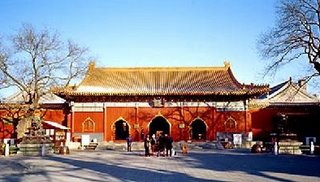 In the northeast corner of the old city of Beijing lies a group of buildings with yellow roofs bounded by a red wall. It is the famous Yonghe Palace, or the Lama Temple of China travel Beijing city, covering an area of 66,400 square meters. This temple is listed as significant historical site protected by the national government.
In the northeast corner of the old city of Beijing lies a group of buildings with yellow roofs bounded by a red wall. It is the famous Yonghe Palace, or the Lama Temple of China travel Beijing city, covering an area of 66,400 square meters. This temple is listed as significant historical site protected by the national government. Gong Li, a Chinese mainland superstar China actress, was given the OK by Oscar winner Jamie Foxx, to play a major role in a movie version of the classic 1980s television show Miami Vice.Following his best actor Oscar for his portrayal of legendary singer Ray Charles in Ray at last month's Academy Awards, Foxx's new status has earned him the right to decide who stars alongside him - and he is more than happy to have Gong Li aboard.
Gong Li, a Chinese mainland superstar China actress, was given the OK by Oscar winner Jamie Foxx, to play a major role in a movie version of the classic 1980s television show Miami Vice.Following his best actor Oscar for his portrayal of legendary singer Ray Charles in Ray at last month's Academy Awards, Foxx's new status has earned him the right to decide who stars alongside him - and he is more than happy to have Gong Li aboard.

















